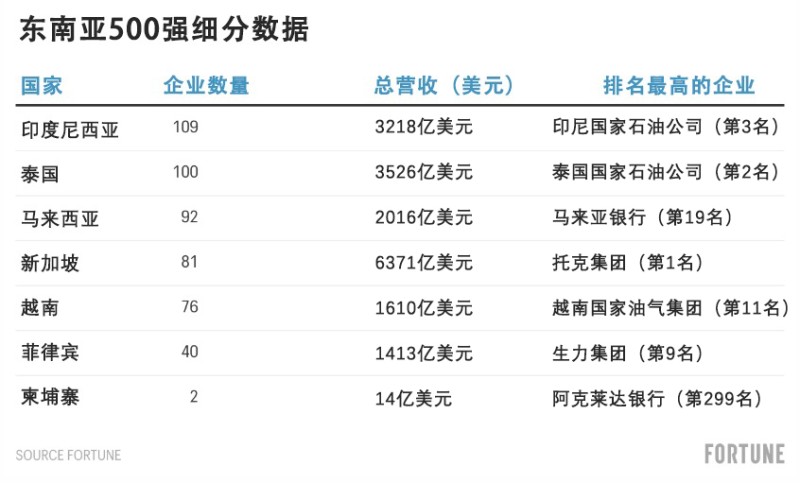
《财富》东南亚500强榜单依据营收规模来衡量地区最大企业,覆盖七个经济体:印度尼西亚、泰国、马来西亚、柬埔寨、越南、菲律宾和新加坡。
作为东南亚地区国内生产总值与人口规模均居首位的经济体,印度尼西亚在榜单中占比最大,109家企业占总排名的五分之一以上。泰国作为该地区第二大经济体,以100家企业位列第二。
新加坡作为该地区人均国内生产总值最高的经济体,企业数量排名处于中游,有81家公司跻身东南亚500强。
不过,若以营收来衡量,这个拥有六百万人口的城市国家却大幅领先东盟邻国。
新加坡上榜企业的总营收达6370亿美元,约占榜单1.8万亿美元总营收的三分之一。

是什么因素推动新加坡在营收排名中实现攀升?
新加坡“三大银行”——星展银行(DBS)、华侨银行(OCBC)和大华银行(UOB)或许是这个城市国家最知名的企业,也是东南亚500强中利润最高的公司。
不过,它们并非榜单上规模最大的新加坡企业。
位居榜首的是托克集团(Trafigura Group),这家大宗商品集团涉足金属、矿产、石油和天然气业务,2024年营收高达2432亿美元,远超榜单上其他所有企业,营收规模几乎是新加坡营收排名第二企业的四倍。
位列第四和第五的丰益国际(Wilmar)与奥兰集团(Olam)均为农业综合企业,深度参与黄油、坚果、谷物和食用油等消费品供应链,2024年营收分别达674亿美元、420亿美元。
新加坡凭借其区域枢纽核心地位,成为企业拓展东南亚业务,尤其是向邻国马来西亚和印尼拓展业务的首选之地。
新加坡作为金融中心的地位也助推其收入份额实现增长。托克集团和伟创力(Flex,排名第十)均在新加坡注册成立,根据《财富》杂志的排名规则,它们被认定为新加坡公司——尽管这两家公司绝大多数业务运营,甚至运营总部,均设在其他国家。(*)
译者:中慧言-王芳
《财富》东南亚500强榜单依据营收规模来衡量地区最大企业,覆盖七个经济体:印度尼西亚、泰国、马来西亚、柬埔寨、越南、菲律宾和新加坡。
作为东南亚地区国内生产总值与人口规模均居首位的经济体,印度尼西亚在榜单中占比最大,109家企业占总排名的五分之一以上。泰国作为该地区第二大经济体,以100家企业位列第二。
新加坡作为该地区人均国内生产总值最高的经济体,企业数量排名处于中游,有81家公司跻身东南亚500强。
不过,若以营收来衡量,这个拥有六百万人口的城市国家却大幅领先东盟邻国。
新加坡上榜企业的总营收达6370亿美元,约占榜单1.8万亿美元总营收的三分之一。
是什么因素推动新加坡在营收排名中实现攀升?
新加坡“三大银行”——星展银行(DBS)、华侨银行(OCBC)和大华银行(UOB)或许是这个城市国家最知名的企业,也是东南亚500强中利润最高的公司。
不过,它们并非榜单上规模最大的新加坡企业。
位居榜首的是托克集团(Trafigura Group),这家大宗商品集团涉足金属、矿产、石油和天然气业务,2024年营收高达2432亿美元,远超榜单上其他所有企业,营收规模几乎是新加坡营收排名第二企业的四倍。
位列第四和第五的丰益国际(Wilmar)与奥兰集团(Olam)均为农业综合企业,深度参与黄油、坚果、谷物和食用油等消费品供应链,2024年营收分别达674亿美元、420亿美元。
新加坡凭借其区域枢纽核心地位,成为企业拓展东南亚业务,尤其是向邻国马来西亚和印尼拓展业务的首选之地。
新加坡作为金融中心的地位也助推其收入份额实现增长。托克集团和伟创力(Flex,排名第十)均在新加坡注册成立,根据《财富》杂志的排名规则,它们被认定为新加坡公司——尽管这两家公司绝大多数业务运营,甚至运营总部,均设在其他国家。(*)
译者:中慧言-王芳
Fortune’s Southeast Asia 500, which measures the largest companies in the region by revenue, covers seven economies: Indonesia, Thailand, Malaysia, Cambodia, Vietnam, the Philippines, and Singapore.
Indonesia, Southeast Asia’s largest economy in terms of both GDP and population, has the biggest footprint on the list, covering more than a fifth of the total ranking with 109 companies. Thailand, the region’s second-largest economy, sits in second place with 100.
Singapore, the region’s wealthiest economy by GDP per capita, sits in the middle of the pack, with 81 companies on the Southeast Asia 500.
Measured by revenue, however, the tiny city-state of six million ends up far ahead of its ASEAN peers.
Total revenue from Singapore-based Southeast Asia 500 companies reached $637 billion, or about a third of the list’s total revenue of $1.8 trillion. That’s twice as much of Thailand, which sits in second place with revenue of $352 billion.
What’s driving Singapore up the revenue rankings?
Singapore’s “Big Three” banks—DBS, OCBC, and UOB—are perhaps the city-state’s most prominent companies. The three banks are the most profitable companies on the Southeast Asia 500.
Yet they’re not actually the largest Singaporean-based companies on the list.
No. 1 on the list is Trafigura Group, a commodities group that deals with metals, minerals, oil, and gas. Trafigura’s revenue for 2024 reached $243.2 billion, more than any other company on the list and almost four times more than the next biggest company by revenue in Singapore.
Wilmar and Olam, No. 4 and No. 5, are both in the agribusiness space. These two companies are deeply embedded in the supply chain for consumer goods like butter, nuts, grains, and cooking oils. Revenues for Wilmar and Olam reached $67.4 billion and $42 billion respectively in 2024.
Singapore’s central position as a hub makes it a prime location for companies hoping to do business across the region, particularly in neighboring Malaysia and Indonesia.
Singapore’s status as a financial center also helps to inflate its revenue share. Trafigura and Flex (No. 10) are both legally domiciled in Singapore, which makes them Singaporean companies according to Fortune’s methodology–even though both companies have most of their operations, and even their operational headquarters, in other countries.

